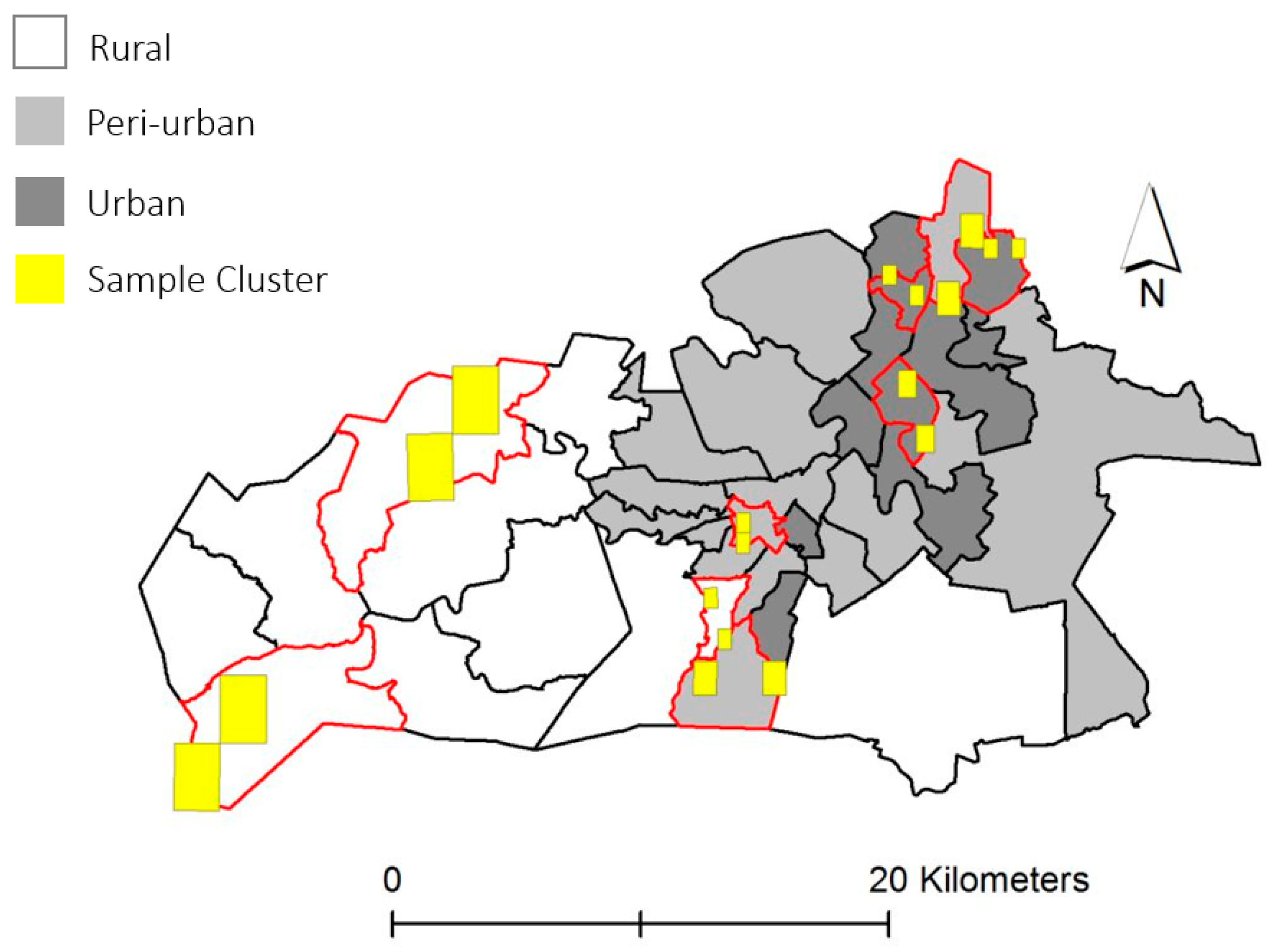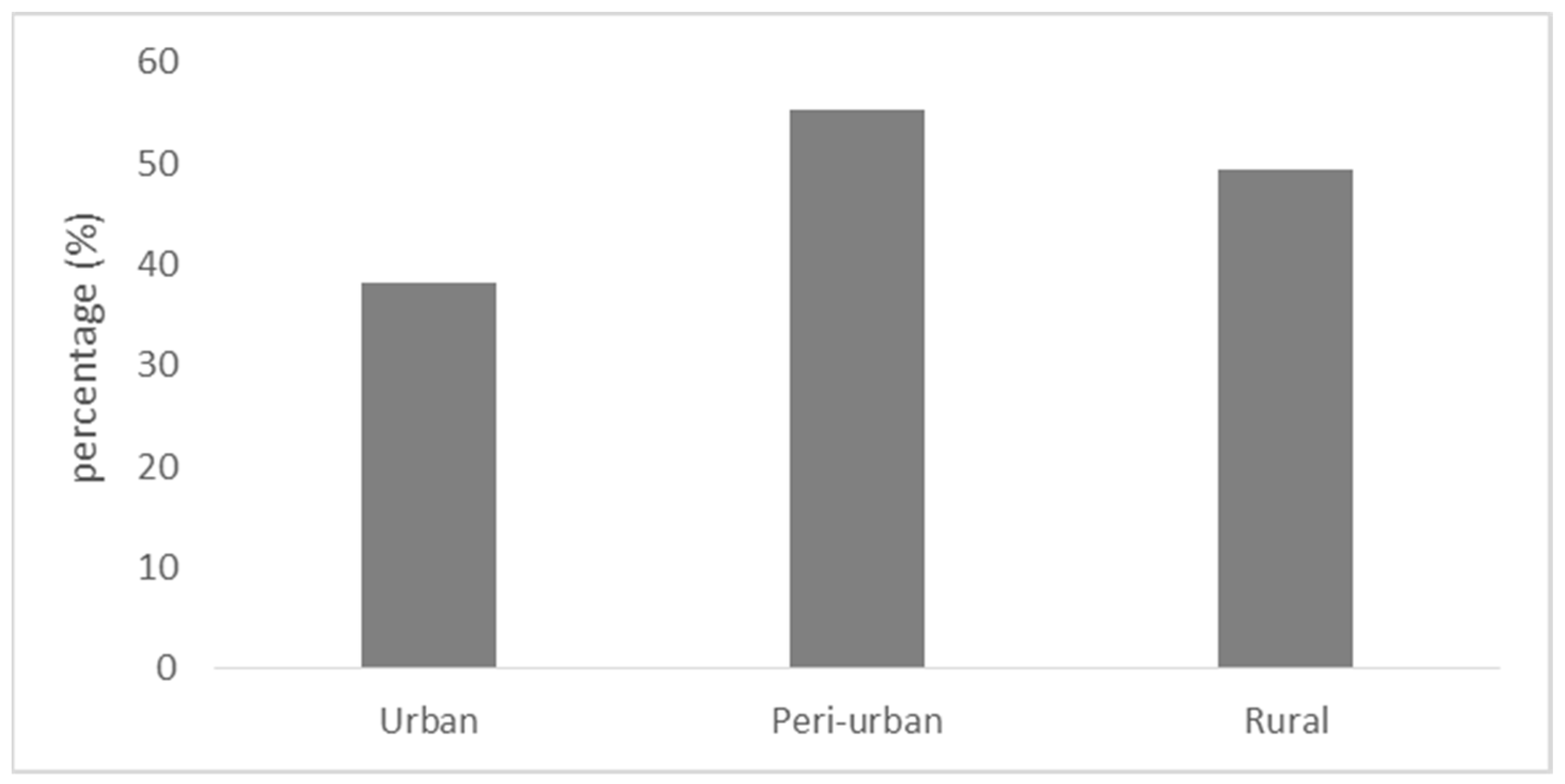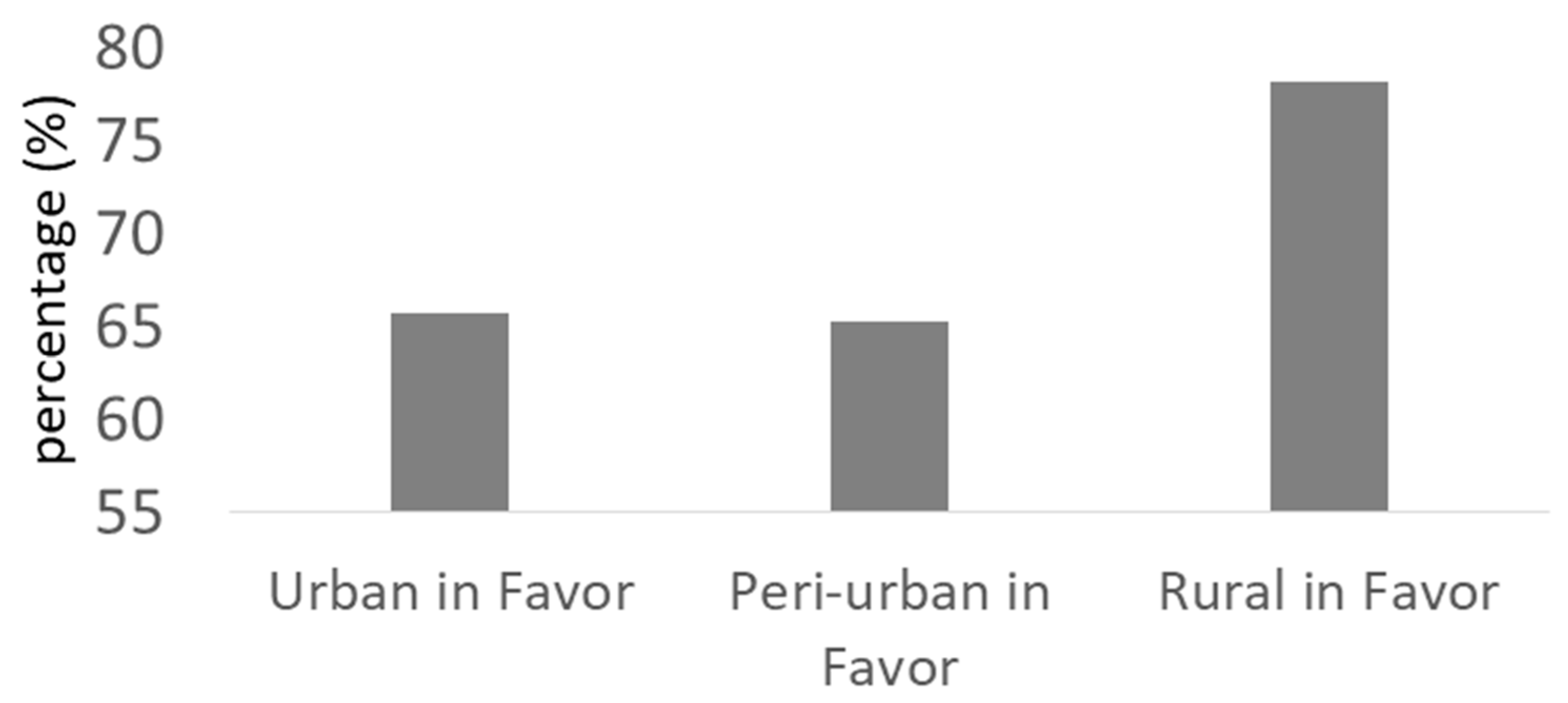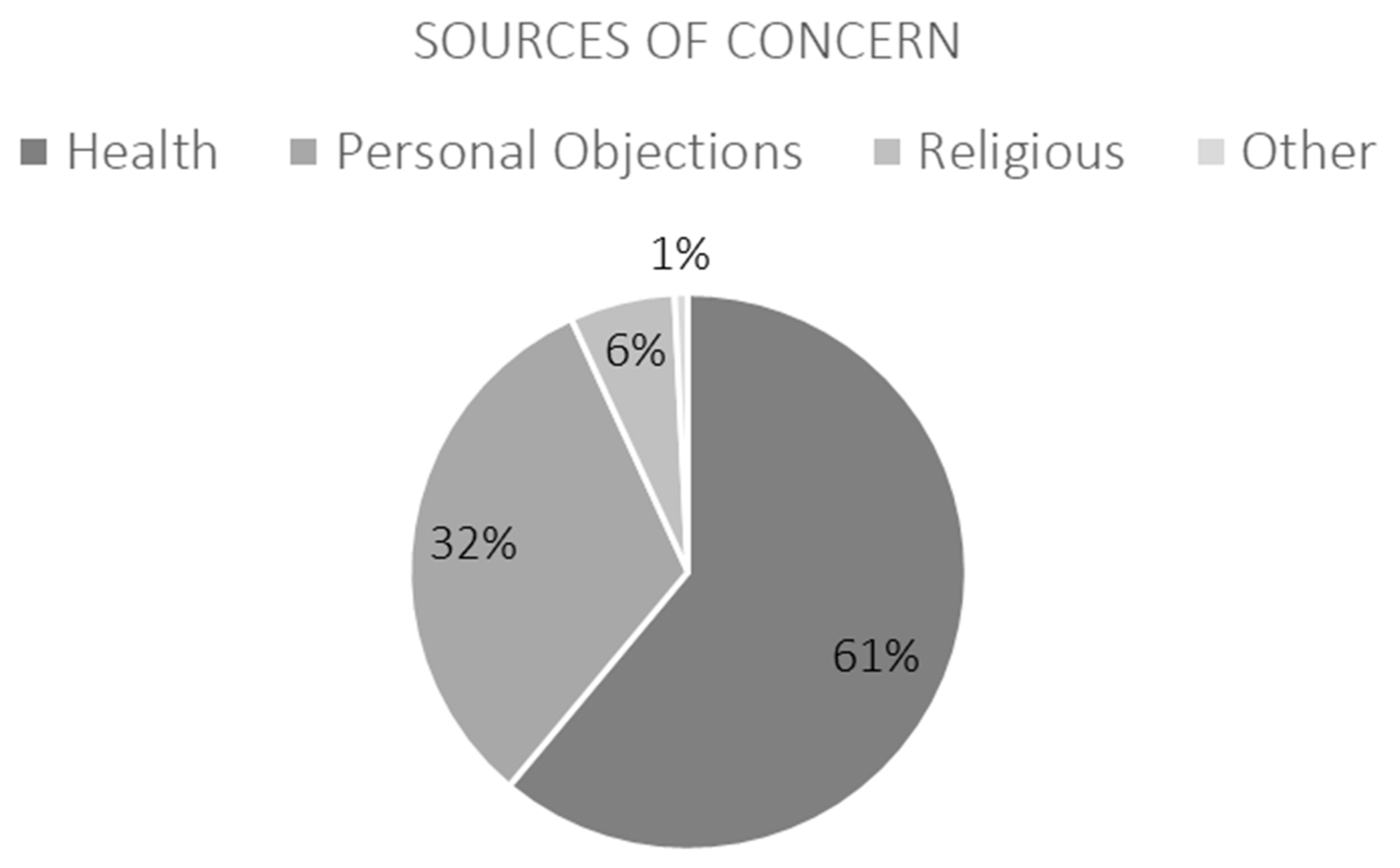Nitrified Human Urine as a Sustainable and Socially Acceptable Fertilizer: An Analysis of Consumer Acceptance in Msunduzi, South Africa
Abstract
:1. Introduction
2. Materials and Methods
3. Results
3.1. Food Insecurity
3.2. Small-Scale Agriculture
3.3. Acceptance
3.3.1. Attitude Toward NUF vs Raw Urine
3.3.2. Willingness to Purchase Food Grown with NUF
4. Discussion
5. Conclusions
Author Contributions
Funding
Acknowledgments
Conflicts of Interest
References
- Baiphethi, M.N.; Jacobs, P.T. The Contribution of Subsistence Farming to Food Security in South Africa. Agrekon 2009, 48, 459–582. [Google Scholar] [CrossRef]
- Sanchez, P.E. Soil Fertility and Hunger in Africa. Science 2002, 295, 2019–2020. [Google Scholar] [CrossRef]
- Etter, B.; Udert, K.M.; Dounden, T. Vuna Final Report; Eawag: Dubendorf, Switzerland, 2015. [Google Scholar]
- Goldstein, J.; Trentmann, F. The Oxford Handbook of the History of Consumption, 1st ed.; Oxford University Press: Oxford, UK, 2012; pp. 326–347. [Google Scholar]
- Bonvin, C.; Etter, B.; Udert, K.M.; Frossard, E.; Nanzer, S.; Tamburini, F.; Oberson, A. Plant Uptake of Phosphorus and Nitrogen Recycled from Synthetic Source- Separated Urine. Ambio 2015, 44, 217–227. [Google Scholar] [CrossRef] [PubMed]
- Udert, K.M.; Buckley, C.A.; Wachter, M.; McArdell, C.S.; Kohn, T.; Strande, L.; Zöllig, H.; Fumasoli, A.; Oberson, A.; Etter, B. Technologies for the treatment of source separated urine in the eThekwini municipality. Water Sa 2015, 41, 212–221. [Google Scholar] [CrossRef]
- Oezel, B.D.; Udert, K.M.; Remmele, A.; McArdell, C.S. Fate of Pharmaceuticals in Source-Separated Urine During Storage, Biological Treatment, and Powdered Activated Carbon Adsoption. Unpublished Manuscript in Preparation.
- Fuenfschilling, L.; Truffer, B. The structuration of socio-technical regimes- Conceptual foundations from institutional theory. Res. Policy 2014, 43, 772–791. [Google Scholar] [CrossRef]
- Cofie, O.; Olugbenga, A.; Amoah, P. Introducing Urine as an Alternative Fertilizer Source for Urban Agriculture: Case Studies from Nigeria and Ghana. Urban Agric. Mag. 2010, 23, 49–50. [Google Scholar]
- Mariwah, S.; Drangert, J.O. Community Perceptions of Human Excreta as Fertilizer in Peri- Urban Agriculture in Ghana. Waste Manag. Resour. 2011, 29, 815–822. [Google Scholar] [CrossRef] [PubMed]
- Mugivhisa, L.L.; Olowoyo, J.O. An Assessment of University Students and Staff Perceptions Regarding the use of Human Urine as a Valuable Soil Nutrient in South Africa. Afr. Health Sci. 2015, 15, 999–1010. [Google Scholar] [CrossRef]
- Okem, A.E.; Xulu, S.; Tilley, E.; Buckley, C.; Roma, E. Assessing perceptions and willingness to use urine in agriculture: A case study from rural areas of eThekwini municipality, South Africa. J. Water Sanit. Hyg. Dev. 2013, 3, 582–591. [Google Scholar] [CrossRef]
- Batel, S.; Devine-Wright, P.; Tangeland, T. Social Acceptance of Low Carbon Energy and Associated Infrastructures: A critical Discussion. Energy Policy 2013, 58, 1–5. [Google Scholar] [CrossRef]
- Huijts, N.M.A.; Molin, E.J.E.; Steg, L. Psychological Factors Influencing Sustainable Energy Technology Acceptance: A Review-Based Comprehensive Framework. Renew. Sustain. Energy Rev. 2012, 16, 525–531. [Google Scholar] [CrossRef]
- Simha, P.; Lalander, C.; Ramanathan, A.; Vijayalakshmi, C.; McConville, J.R.; Vinnerås, B.; Ganesapillai, M. What do consumers think about recycling human urine as fertiliser? Perceptions and attitudes of a university community in South India. Water Res. 2018, 143, 527–538. [Google Scholar] [CrossRef] [PubMed]
- Caesar, M.; Crush, J.; Hill, T. The State of Food Insecurity in Msunduzi Municipality, South Africa; African Food Security Urban Network: Rondebosch, South Africa, 2013. [Google Scholar]
- Statistics South Africa. Available online: www.statssa.gov.za (accessed on 11 December 2018).
- Mkhize, N.; Taylor, M.; Udert, K.; Gounden, T.; Buckley, C. Urine diverstion dry toilets in eThekwini municipality, South Africa: Acceptance, use and maintenance through users’ eyes. J. Water Sanit. Hyg. Dev. 2017, 7, 111–120. [Google Scholar] [CrossRef]
- Black, M.; Fawcett, B. The Last Taboo: Opening the Door on the Global Sanitation Crisis; Routledge: New York, NY, USA, 2010. [Google Scholar]
- Jewitt, S. Poo gurus? Researching the threats and opportunities presented by human waste. Appl. Geogr. 2011, 31, 761–769. [Google Scholar] [CrossRef] [Green Version]
- Hoffman, V.; Chrisinck, A.; Probst, K. Farmers and Researchers: How can collaborative advantages be created in participatory research and knowledge development? Agric. Hum. Values 2007, 24, 355–368. [Google Scholar] [CrossRef]
- Siegrist, M. The Influence of Trust and Perceptions of Risks and Benefits on the Acceptance of Gene Technology. Risk Anal. 2000, 20, 195–203. [Google Scholar] [CrossRef] [PubMed]
- McDonald, D.A. World City Syndrome: Neoliberalism and Inequality in Cape Town; Routledge: New York, NY, USA, 2008. [Google Scholar]
- Van de Ven, A.; Polley, D.; Garud, R.; Venkataraman, S. The Innovation Journey; Oxford University Press: New York, NY, USA, 1999. [Google Scholar]
- Deuten, J.; Rip, A.; Jelsma, J. Societal embedding and product creation management. Technol. Anal. Strateg. Manag. 1997, 9, 131–148. [Google Scholar] [CrossRef] [Green Version]
- Geels, F.; Verhees, B. Cultural legitimacy and framing struggles in innovation journeys: A cultural-performative perspective and a case study of Duthc nuclear energy. Technol. Forecast. Soc. Chang. 2011, 78, 910–930. [Google Scholar] [CrossRef]
- Pahl-Wostl, C.; Schonborn, A.; Willi, N.; Muncke, J.; Larsen, T.A. Investigating consumer attitudes towards the new technology of urine separation. Water Sci. Technol. 2003, 48, 57–65. [Google Scholar] [CrossRef]
- Taher, M.N.; Basar, A.; Abdelrahman, A.M.; Baykal, B.B. Yellow Water to Aid Food Security- Perceptions/Acceptance of Consumers toward Urine Based Fertilizer. Proceedings 2018, 2, 606. [Google Scholar] [CrossRef]
- Swiss Federal Institute of Aquatic Science and Technology. Available online: https://www.eawag.ch/de/abteilung/eng/projekte/aurin-duenger-aus-urin/ (accessed on 18 March 2019).
- Hoogma, R.; Kemp, R.; Schot, J.; Truffer, B. Experimenting for Sustainable Transport. The approach of Strategic Niche Management; Rout & Taylor: London, UK, 2002. [Google Scholar]
- Smith, A.; Raven, R. What is protective space? Reconsidering niches in transitions to sustainability. Res. Policy 2012, 6, 1025–1036. [Google Scholar] [CrossRef]
- Andersson, E. Turning waste into value: Using human urine to enrich soils for sustainable food production in Uganda. J. Clean. Prod. 2015, 96, 290–298. [Google Scholar] [CrossRef]







| Gender | Number of Responses | Response Percentage |
|---|---|---|
| Male | 157 | 40.0 |
| Female | 235 | 59.9 |
| RACE/ETHNICITY | ||
| Black/African | 338 | 86.2 |
| Indian | 30 | 7.6 |
| White | 19 | 4.8 |
| Colored | 5 | 5 |
| AGE | ||
| 16–30 | 129 | 33.0 |
| 31–45 | 111 | 28.3 |
| 46–60 | 78 | 20.0 |
| 61 + | 58 | 14.8 |
| No Response | 14 | 3.5 |
| INCOME BRACKET | ||
| 0–1500 | 187 | 48.1 |
| 1501–3500 | 51 | 13.1 |
| 3501–5000 | 21 | 5.4 |
| 5001–10000 | 7 | 1.8 |
| 1001–15000 | 11 | 2.8 |
| >15000 | 13 | 3.3 |
| No Response | 98 | 25.2 |
| EDUCATION | ||
| <Primary School | 36 | 9.2 |
| Completed Primary | 98 | 25.0 |
| High School | 180 | 46.0 |
| University | 46 | 11.7 |
| No Response | 31 | 7.9 |
| RELIGION | ||
| Christianity | 300 | 76.7 |
| Islam | 22 | 5.6 |
| Hinduism | 13 | 3.3 |
| Judaism | 0 | 0 |
| None | 14 | 3.5 |
| Other | 31 | 7.9 |
| No Response | 11 | 2.8 |
| Engaged in Agriculture | Number of Responses | Response Percentage |
|---|---|---|
| Yes | 214 | 54.7 |
| No | 174 | 44.5 |
| No response | 3 | 0.7 |
| Purpose of Agriculture | ||
| Subsistence | 152 | 71.0 |
| Income | 5 | 2.3 |
| Both | 54 | 25.2 |
| Other | 3 | 1.5 |
| Change in Opinion | B (SE) | Lower | 95% CI FOR OD | Upper |
|---|---|---|---|---|
| Intercept | −0.50 (0.48) | 0.15 | 0.60 | 2.42 |
| HUNGER 2 | 0.11 (0.78) | 0.51 | 1.12 | 2.45 |
| HUNGER 3 | −0.23 (0.57) | 0.35 | 0.80 | 1.80 |
| HUNGER 4 | 0.44 (0.27) | 0.71 | 1.55 | 3.46 |
| RACE 2 | 1.60 (0.05) | 1.07 | 4.95 | 28.71 |
| RACE 3 | 0.54 (0.38) | 0.51 | 1.71 | 5.79 |
| INCOME 2 | −0.08 (0.78) | 0.50 | 1.00 | 1.70 |
| RELIGION 2 | −0.87 (0.31) | 0.07 | 0.42 | 2.09 |
| RELIGION 3 | −1.08 (0.27) | 0.04 | 0.34 | 2.24 |
| RELIGION 4 | −0.42 (0.34) | 0.27 | 0.66 | 1.57 |
| AGE 2 | −0.79 (0.02) * | 0.23 | 0.46 | 0.90 |
| AGE 3 | −0.97 (0.01) * | 0.17 | 0.38 | 0.82 |
| AGE 4 | −0.54 (0.25) | 0.23 | 0.58 | 1.50 |
| GENDER 2 | 0.19 (0.50) | 0.70 | 1.21 | 2.10 |
| EDUCATION 2 | 0.16 (0.78) | 0.41 | 1.17 | 3.41 |
| EDUCATION 3 | 0.54 (0.30) | 0.62 | 1.72 | 4.94 |
| EDUCATION 4 | −0.19 (0.78) | 0.21 | 0.82 | 3.28 |
| WARD 2 | 0.33 (0.37) | 0.69 | 1.38 | 2.85 |
| WARD 3 | 1.15 (0.005) ** | 1.44 | 3.15 | 7.13 |
| Yes | Most Likely Yes | Most Likely No | No | Total | Χ2 | |
|---|---|---|---|---|---|---|
| WARD | 0.011 | |||||
| Urban | 45 (42.9%) | 24(22.9%) | 6 (5.7%) | 30 (28.6%) | 105 | |
| Peri-Urban | 70 (41.9%) | 40 (24.1%) | 19 (11.4%) | 39 (23.4%) | 167 | |
| Rural | 74 (62.2%) | 19 (16.0%) | 7 (5.9%) | 19 (16%) | 119 | |
| GENDER | 0.827 | |||||
| Male | 76 (49.7) | 39(23.4) | 12(7.8) | 31(20.3) | 153 | |
| Female | 107 (46.5) | 48(20.9) | 20(8.7) | 55(23.9) | 230 | |
| INCOME | 0.871 | |||||
| 0-1500 | 81 (45.8) | 40(22.6) | 17(9.6) | 39(22.0) | 177 | |
| >1500 | 131 (47.3) | 63(22.7) | 25(9) | 58(20.9) | 100 | |
| EDUCATION | 0.544 | |||||
| Did not finish primary school | 12 (36.4) | 10(30.3) | 4(12.1) | 7(21.2) | 33 | |
| Completed primary school | 49 (50.0) | 17(17.3) | 7(7.1) | 25(25.5) | 98 | |
| Completed high school | 88 (49.4) | 38(21.3) | 15(8.4) | 37(20.8) | 178 | |
| Completed university | 18 (47.3) | 14(31.8) | 5(11.4) | 7(15.9) | 44 | |
| RACE | 0.029 | |||||
| Black (African) | 171 (50.7) | 65 (19.3) | 29 (8.6) | 72 (21.4) | 317 | |
| Other (Indian, White, Colored) | 18 (32.7) | 18 (32.7) | NA | 16 (29.1) | 52 | |
| AGRICULTURE | 0.065 | |||||
| Engaged | 109 (50.7) | 51 (23.7) | 12 (5.6) | 43 (20.0) | 215 | |
| Not Engaged | 80 (45.2) | 32 (18.1) | 20 (11.3) | 45 (25.4) | 177 |
© 2019 by the authors. Licensee MDPI, Basel, Switzerland. This article is an open access article distributed under the terms and conditions of the Creative Commons Attribution (CC BY) license (http://creativecommons.org/licenses/by/4.0/).
Share and Cite
Wilde, B.C.; Lieberherr, E.; Okem, A.E.; Six, J. Nitrified Human Urine as a Sustainable and Socially Acceptable Fertilizer: An Analysis of Consumer Acceptance in Msunduzi, South Africa. Sustainability 2019, 11, 2456. https://doi.org/10.3390/su11092456
Wilde BC, Lieberherr E, Okem AE, Six J. Nitrified Human Urine as a Sustainable and Socially Acceptable Fertilizer: An Analysis of Consumer Acceptance in Msunduzi, South Africa. Sustainability. 2019; 11(9):2456. https://doi.org/10.3390/su11092456
Chicago/Turabian StyleWilde, Benjamin C., Eva Lieberherr, Andrew E. Okem, and Johan Six. 2019. "Nitrified Human Urine as a Sustainable and Socially Acceptable Fertilizer: An Analysis of Consumer Acceptance in Msunduzi, South Africa" Sustainability 11, no. 9: 2456. https://doi.org/10.3390/su11092456
APA StyleWilde, B. C., Lieberherr, E., Okem, A. E., & Six, J. (2019). Nitrified Human Urine as a Sustainable and Socially Acceptable Fertilizer: An Analysis of Consumer Acceptance in Msunduzi, South Africa. Sustainability, 11(9), 2456. https://doi.org/10.3390/su11092456





